|
|
|
|
|
 CHAPTER 2
CHAPTER 2Amlici seeks to be king and is rejected by the voice of the people—His followers make him king—The Amlicites make war on the Nephites andare defeated—The Lamanites and Amlicites join forces and are defeated—Alma slays Amlici. [87 B.C.] |
|||
|
1 AND it came to pass in the commencement of the
*fifth year of their reign there began to be a contention
among the people; for a certain aman, being called Amlici,
he being a very cunning man, yea, a wise man as to the wisdom of the
worlda, he being after the
order of the man that slew
bGideonb by the
sword, who was executed according to the law—
2 Now this Amlici had, by his cunning, adrawn away much people after him; even so much that they began to be very powerful; and they began to endeavor to establish Amlici to be king over the people. 3 Now this was alarming to the people of the church, and also to all those who had not been drawn away after the persuasions of Amlici; for they knew that according to their law that such things must be established by the avoice of the people.
|
1a a wise man as to the wisdom of the
world To be learned is good is that learning and wisdom is direct
by the Spirit of God and NOT exercised as to a law of logic and contrivance
unto itself. Many men consider themselves high and better and to know more
and be more intelligent than other men because of their 'high learning'. This
is NOT the case. Intelligence is not a mere matter of I.Q. The truly
intelligent man is he who follows the directions of the Spirit of God even
when it IS NOT according to his own wisdom and logic. Truth does not always
take the path of what is most reasonable and logical according to the
understanding of men. Men have contrived of themselves many a plan and
direction which they of themselves felt that was the obtainable by them,
placing themselves above others and not listening to and adhereing to the
directions of God. In such cases where their own personal level of learning
becomes their 'God' above that of the 'revealed intelligence of God', men
have and will always fail in relying upon the strength of their own deduction
and reasoning and contrivance to do as they would of themselves do. Only in
following the direction of the Spirit of God will man suceed in the Lord. And
that pride which raises oneself up in their own eyes above another, thinking
themselves better than, above and over another, even to be above the law,
will be unto their own destruction. For so thought Lucifer of himself, that
he would raise himself above the law of God, opposing the plan of God, and
establishing himself to be over all, making and taking unto himself the glory
of God above all other men and God.
1b after the order of the man that slew Gideon This order was the order of Nehors. It was first practiced by the wicked priests of King Noah in the lands of Lehi-Nephi and Shilom which were in the land of Nephi. When the people of Limhi came into the land, it appears that some of them still sought after the ways of the wicked priests and did seek to establish 'priestcraft' which had not before been practiced in the land of Zarahemla. And now this man which was of the order of Nehor did also seek to establish a king in the land, a wicked king after the order of Nehors like unto King Noah. |
1*
[87 B.C.] a Alma 1:15; Alma 16:11; Alma 24:28-30 b Alma 1:8; 2a 2 Sam. 15:6 (1-10) 3a Mosiah 29:25-27; Alma 4:16-17
|
|
|
4 Therefore, if it were possible that Amlici should gain the voice
of the people, he, being a wicked man, would adeprive them
of their rights and privileges of the church; for it was his intent to
destroy the church of God.
5 And it came to pass that the people assembled themselves together throughout all the land, every man according to his mind, whether it were for or against Amlici, in separate bodies, having much dispute and wonderful acontentions one with another. 6 And thus they did assemble themselves together to cast in their avoices concerning the matter; and they were laid before the judges.
|
4a
Mosiah 29:27;
Alma 10:19;
Hel. 5:2 5a Alma 11:29 6a TG Common Consent
|
||
|
7 And it came to pass that the avoice of the
people came against Amlicia, that
he was not made king over the people.
8 Now this did cause much joy in the hearts of those who were against him; but Amlici did stir up those who were in his favor to anger against those who were not in his favor. 9 And it came to pass that they gathered themselves together, and did aconsecrate Amlici to be their king.
|
7a the voice of the people came against Amlici Now this was the first test of the new democracy established in the nation of Zarahemla. And though we do not know the exact process, we were told that when the judges where called that various representatives of the people did go forth and take a count of the people and their voice as to whom they would have to be their judges. Thus we must suppose that a 'legal proposition' was drafted and thus sent forth unto all the people in the same manner and that the voice of the whole people of the whole nation were so polled and taken concerning this matter of whether the people should have a king or not. |
7a
Mosiah 29:25-27 9a TG Unrighteous Dominion
|
|
|
10 Now when Amlici was made king over them he commanded them
that they should take up arms against their brethren; and this he
did that he might subject them to him.
11 Now the people of Amlici were distinguished by the name of Amlici, being called aAmlicites; and the remainder were bcalled Nephites, or the people of God. 12 Therefore the people of the Nephites were aware of the intent of the Amlicites, and therefore they did prepare to meet them; yea, they did arm themselves with swords, and with cimeters, and with bows, and with arrows, and with stones, and with slings, and with all manner of aweapons of war, of every kind.
|
11a
Alma 3:4 b Jacob 1:14 (13-14); Mosiah 25:12; Alma 3:11, 17 12a Alma 10:8; Hel. 1:14
|
||
|
13 And thus they were prepared to meet the Amlicites at the time of
their coming. And there were appointed acaptains, and
higher captains, and chief captains, according to their numbers.
14 And it came to pass that Amlici did arm his men with all manner of weapons of war of every kind; and he also appointed rulers and leaders over his people, to lead them to war against their brethren. 15 And it came to pass that the Amlicites came upon the hill Amnihu, which was east of the a:ariver Sidona, which ran by the bland of Zarahemlaa, and there they began to make war with the Nephites.
|
15a river Sidon Pointed out by such as George
Reynolds and confirmed in Orson Pratts' footnotes, the River Sidon is considered to be the
same as the Magdalena River in Colombia (1906 Liverpool edition footnote). 15b land of Zarahemla Care needs be taken when dealing with the term and phrase of 'land of Zarahemla'. Zarahemla was a city, the land of Zarhamela was a locally surrounding province or county round about the city of Zarahemla, and also 'the land of Zarahemla' could have reference to the entire nation of the Nephites called Zarahemla and/or the land of Zarahemla depending upon the context of the text. Like New York, New York, New York; where New York was a city, a bourough/county (Manhatten),and a state: so also Zarahemla, Zarahemla, Zarahemla; could be referring to the limited city by that name, the provinice or county by the name or even the entire Nephite Nation by that same name, Zarahemla. |
13a
Alma 16:5 15a Alma 3:3 aSupposed to be Magdalena (1906 Ed.) b Omni 1:13; Mosiah 1:1
|
|
16 Now Alma, being the achief judge and the
bgovernor of the people of Nephi, therefore he went up with
his people, yea, with his captains, and chief captains, yea, at the head of
his armies, against the Amlicites to battle.
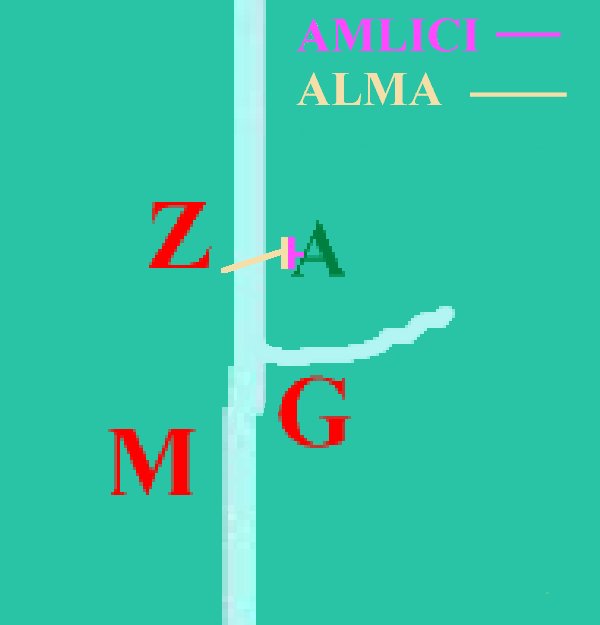 18 Nevertheless the Lord did strengthen the hand of the Nephites, that they slew the Amlicites with great slaughter, that they began to flee before them.
|
16a
Mosiah 29:42 b Mosiah 1:10
|
||
19 And it came to pass that the Nephites did pursue the Amlicites all
that day, and did slay them with much slaughter, insomuch that there were
aslain of the Amlicites twelve thousand five hundred thirty
and two souls; and there were slain of the Nephites six thousand five hundred
sixty and two souls.
 21 And Alma sent spies to follow the remnant of the Amlicites, that he might know of their plans and their plots, whereby he might guard himself against them, that he might preserve his people from being destroyed.
|
20a the valley of Gideon The Sidon river valley ran north and south with Manti in the head waters, a wilderness, then Minon just above Zarahemla and then the provincial land of Zarahemla in the heart and center of the land. Within one days travel from Zarahemla south and on the east of the river was a tributary river from the east and of coures its own valley land. This valley, which coorelates well with that river, the Meta River of Colombia, and its valley which turns up to Bogata from off the Magdalena River in Colombia, was founded by Gideon as a part, the more righteous part, of the people of Limhi did settle that land with Gideon when they returned from the land of Nephi. It was at the mouth or beginning of that valley upon that side river that Alma encamped for the night. |
19a
Alma 3:1-2,26;
Alma 4:2 20a Alma 6:7; Alma 8:1 b Alma 1:12 (7-15); Alma 14:16
|
|
22 Now those whom he had sent out to watch the camp of the
Amlicites were called Zeram, and Amnor, and
Mantia, and Limher;
these were they who went out with their men to watch the camp of
the Amlicites.
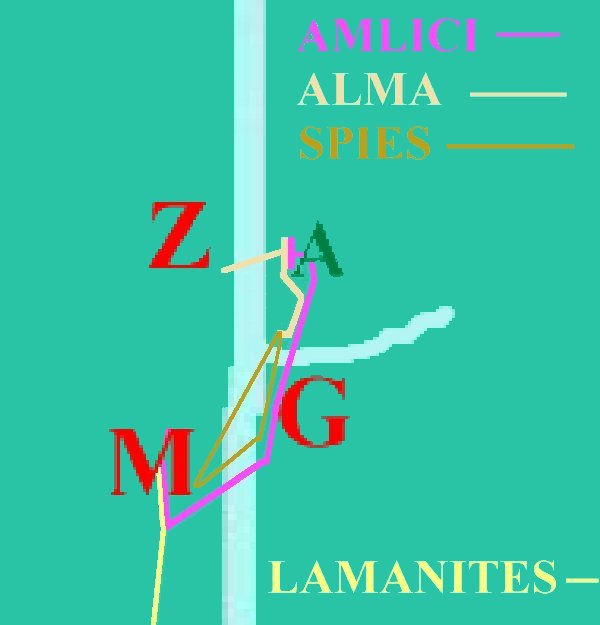 24 Behold, we followed the acamp of the bAmlicites, and to our great astonishment, in the land of Minon, above the land of Zarahemla, in the course of the land of cNephi, we saw a numerous host of the Lamanites; and behold, the Amlicites have joined them; 25 And they are upon our brethren in that land; and they are fleeing before them with their flocks, and their wives, and their children, towards our city; and except we make haste they obtain possession of our city, and our fathers, and our wives, and our children be slain.
|
22a Manti Whether this name given here is coinsidence or not, it is suggestive. Above, to the south of the city of Zarahemla was the land of Minon. And continuing south up the valley into the upper mountain in the course of going to the land of Nephi would be where the city and land of Manti would be located. It begs the question if this Manti was he who establishes the city and land of Manti as a part of a further south 'outpost' city of defense and early warning. But the Book of Mormon being only less than a 1% record of the people, such fuller details just are not elaborated upon in the highly abridged Book of Mormon. |
24a
Alma 3:20 b Alma 3:4, 13-18 c 2 Ne. 5:8; Alma 20:1
|
|
26 And it came to pass that the people of Nephi took their tents, and
departed out of the valley of Gideon towards their acity,
which was the city of aZarahemla.
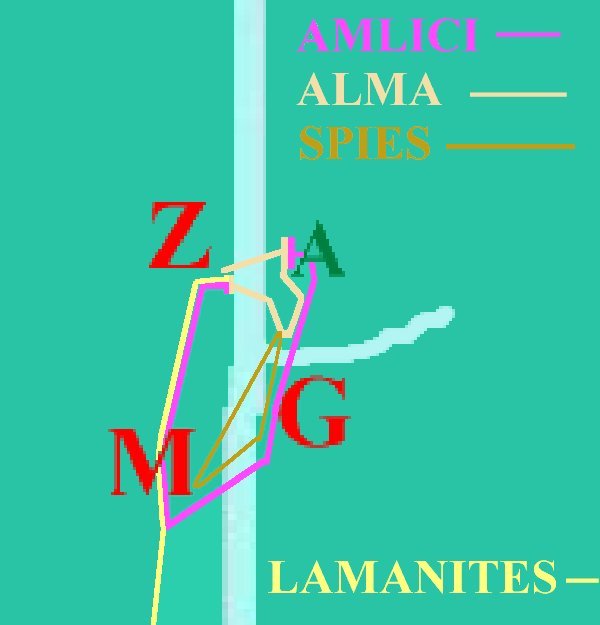 28 Nevertheless, the Nephites being astrengthened by the hand of the Lord, having prayed mightily to him that he would deliver them out of the hands of their enemies, therefore the Lord did hear their cries, and did strengthen them, and the Lamanites and the Amlicites did fall before them.
|
26a
Alma 6:4 b Omni 1:14, 18 27a Jarom 1:6 28a Deut. 31:6
|
||
|
29 And it came to pass that Alma fought with Amlici with the
sword, face to face; and they did contend mightily, one with
another.
30 And it came to pass that Alma, being a man of God, being exercised with much afaith, cried, saying: O Lord, have mercy and bspare my life, that I may be an instrument in thy hands to save and preserve this people. 31 Now when Alma had said these words he contended again with Amlici; and he was strengthened, insomuch that he slew Amlici with the sword.
|
30a
TG
Faith b Alma 3:22
|
||
|
32 And he also contended with the king of the Lamanites; but the
king of the Lamanites fled back from before Alma and sent his
guards to contend with Alma.
33 But Alma, with his guards, contended with the guards of the king of the Lamanites until he slew and drove them back. 34 And thus he cleared the ground, or rather the bank, which was on the west of the river Sidon, athrowing the bodies of the Lamanites who had been slain into the waters of Sidon, that thereby his people might have room to cross and contend with the Lamanites and the Amlicites on the west side of the river Sidon.
|
34a
Alma 3:3;
Alma 44:22
|
||
|
35 And it came to pass that when they had all crossed the river
Sidon that the Lamanites and the Amlicites began to flee before
them, notwithstanding they were so numerous that they could not
be numbered.
36 And they fled before the Nephites towards the wilderness which was west and north, away beyond the borders of the land; and the Nephites did pursue them with their might, and did slay them.
|
|||
|
37 Yea, they were met on every hand, and slain and driven, until
they were scattered on the west, and on the
northa, until they had
reached the wilderness, which was called bHermounts; and it was that
part of the wilderness which was infested by wild and ravenous
beastsb.
38 And it came to pass that many died in the wilderness of their wounds, and were devoured by those beasts and also the vultures of the air; and their bones have been found, and have been heaped up on the earth.
37b the wilderness, which was called
Hermounts; and it was that part of the wilderness which was infested by wild
and ravenous beasts In one sense of this statement it seems to
be given in a spirit of familiarity, that one ought to already know to what
wilderness is being referred to here. 'It was that part of the
wilderness which was infested by wild and ravenous beasts.' Now you
ought to know which wilderness it is that Mormon is referring. According to
Joseph Smith, 'Lehi landed a little south of the Isthmus of Darien. This
would have been upon the northwestern shore of Colombia. When Lehi's party
proceeded to take their journey into the wildernes after that first season
of planting and harvesting that bounteous crop which fostered the naming of
this first land of the promises land after that bounteous land from which
they departed, Bountiful; they did find in the forested wilderness animals
of every kind both domesitic and also wild beast of every kind. This is that
same wilderness, that rain forested 'jungle' land which the Nephites called
Hermounts. And it is with the 'familiar reference' that Mormon speaks of
'that wilderness infested with wild and ravenous beasts', as the easy
kill of the domestic animals has by now elapsed.
Notice the three parallel mountain ranges of the western, centeral and eastern cordilleras or mountains, the two major river valleys thus created, the wastern seaboard consumed in a 300 plus inches per year mangrove swamp natural barrier, he eastern plains, and the most northern upper regions including the narrow neck which would consist of the land known as Bountiful. Bountiful: City on the east coast, land runs from west sea to east sea and up into the narrow neck bordering upon the land of Desolation. Mulek: Possibly a sea port fishing villege either in the land of Bountiful of the greater land of Jershon at this time. Jershon: Vast northeastern plains lands of the eastern seaboard given to the people of Ammon, being similar to the dryer lands of the western coast of the land of Nephi. Antionum: Land of the Zormanites which disscents over to the Lamanites (Alma 43:4-5). Unnamed ?: 'Capital' lands in lower Sidon Valley (Helaman 1:23-27). Zarahemla: City and local lands of Zarahemla. Not to be confused with the greater nation of Zarahemla which included all lands. Minon: Land immediately south of Zarahemla in central Sidon Valley. Gideon: Land in eastern cutting valley which cuts across the eastern cordilleras to the plains lands. Aaron: City and land on the fringe of the eastern plains coming out of the Gideon passage. Manti: Early warning city and land located in the head waters of the upper Sidon valley. Sidom, Noah and Ammonihah: Cities and lands of lower parallel valley. Melek: Land in upper parallel valley. Rest of Land: Vast expanses of mountainous and rain forest jungle lands and mangrove swamps which dominate the national lands which are merely DOTTED with cities and lands which have began to spread forth over the land. Wilderness of Her - Mounts: The land being presumed of feminine gender (her) and thus the wilderness of 'her mountains' filled practically the whole of the mountain lands, north, south, east and west. Only the wilderness of the mountains to the north and west is where the Lamanites and Amlicites were driven (verse 37). |
37a scattered on the west, and on the
north Now an understanding as to the nature of the national lands
of Zarahemla is needful. It is true that the people of the Nephites had
began to spread over the face of the land. But even in their so settling new
lands and establishing new cities, there was vast wildernesses between each
of the lands and their associated cities. And there would be in and as a
cause of these wildernesses such physical land features which would not be
suited for civilization. One such type of natural feature is or are
mountainous regions of the land. The national land of Zarahemla had three
parallel mountian ranges. Not exactly like but comparable to the four parallel
mountain ranges of Utah's northern regions. Utah has the Wasatch Mountain
Range, then the Oqquirh Mountain Range, then the Standbury Mountain Range. and
finally the Cedar Range. While all these sub-ranges are technically a part of
the great Wasatch Mountains, they provide three parallel valleys within the
four ranges. These valleys are Skull Valley, Tooele Valley and the Salt
Lake Valley. Now the three parallel mountain ranges of the land of Zarahemla
are best named the Eastern Mountains or Cordillera, the Central Mountains of
Cordillera, and the Western Mountains or Cordillera. Between the Eastern
Cordillera and the Central Cordillera lies the Sidon River valley which
contains from the head waters in the south Manti, Minon, Zarahemla and other
unnamed cities and lands. And between the Centeral Cordillera and the Western
Cordillera lies a parallel river which contains such lands and cities as
Melek, Ammonihah, Noah and Sidom. The Lands of Melek and Ammonihah in the
parallel valley to the Sidon valley are separated by a three day wilderness
journey perhaps by river which places the distance up from 75 to 200 miles
apart. The Central Cordillera Mountain range is a wilderness unto itself.
And when the Book of Mormon states the the wilderness to the west of Zarahemla
and north of Zarahemla, these Central Cordillera Mountains come into play
as does also the lands of Melek and Ammonihah. The Lamanites and Amlicites
were driven into the Central Cordilleras where wild beast of every kind did
dwell. The Southern regions of Bountiful would consist of the northern
regions of the wilderness of Hermounts. To the east of Melek and Ammonihah
and the vast three day wilderness journey inbetween lies the western slopes
of the Central Cordilleras. 'IF' the Lamanites and Amilites were able to
transverse the Centeral Cordilleras to the west the would still most likely
further find themselves in this three day wilderness between Melek and
Ammonihah which was still a part of the wilderness of Hermounts. The fact that
various Nephite settlements began to 'DOT' the various valley regions of the
Hermounts wilderness, did none the less consist of mostly jungle rain forest
type wilderness and high mountains wilderness regions. The name 'HER - MOUNTS'
may also be a descriptive name rather than an actual Nephite name. Since
the Wilderness of 'HER-MOUNTS' most likely consisted of the wilderness areas
of the Central and Western Mountains and considering the land and its mountian
ranges to be 'feminine' in gender, the Wilderness of 'her-mountains' seems a
likely possibile disection of this descriptive wilderness name.
|
37a
1 Ne. 18:25 (23-25);
Alma 22:31 (29-33)
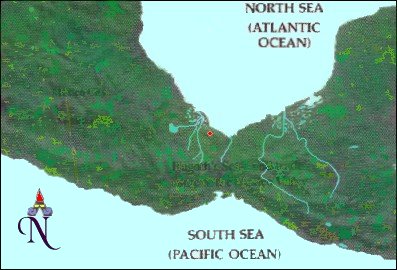  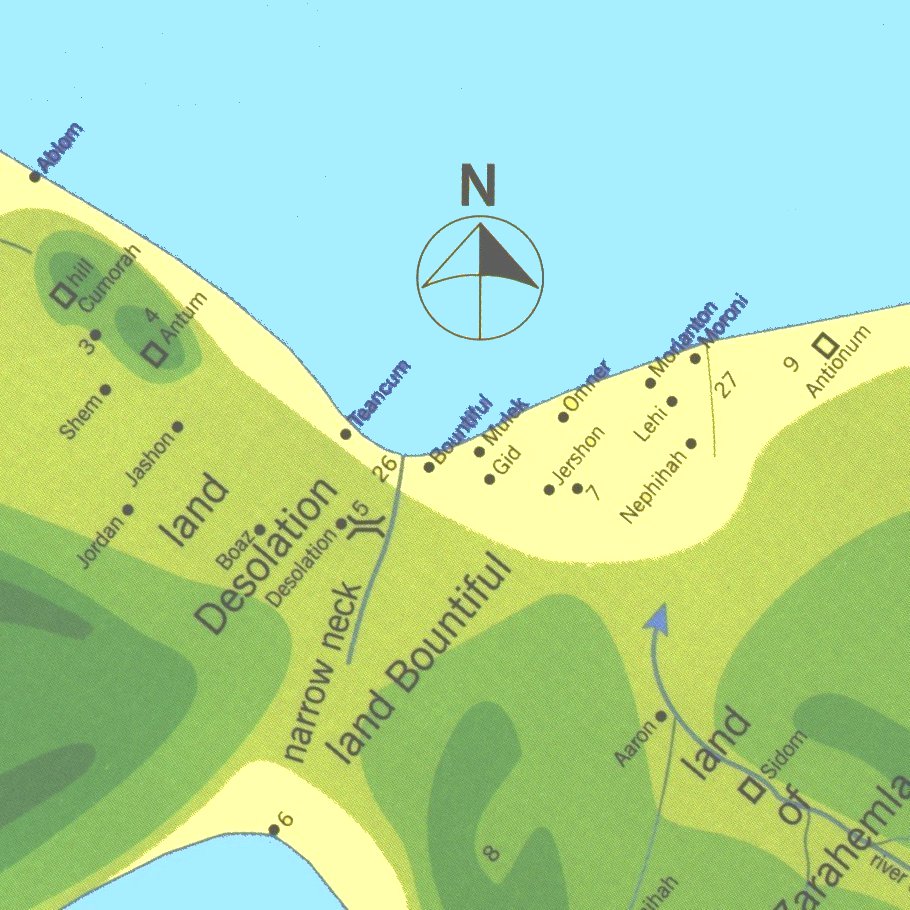 |
|
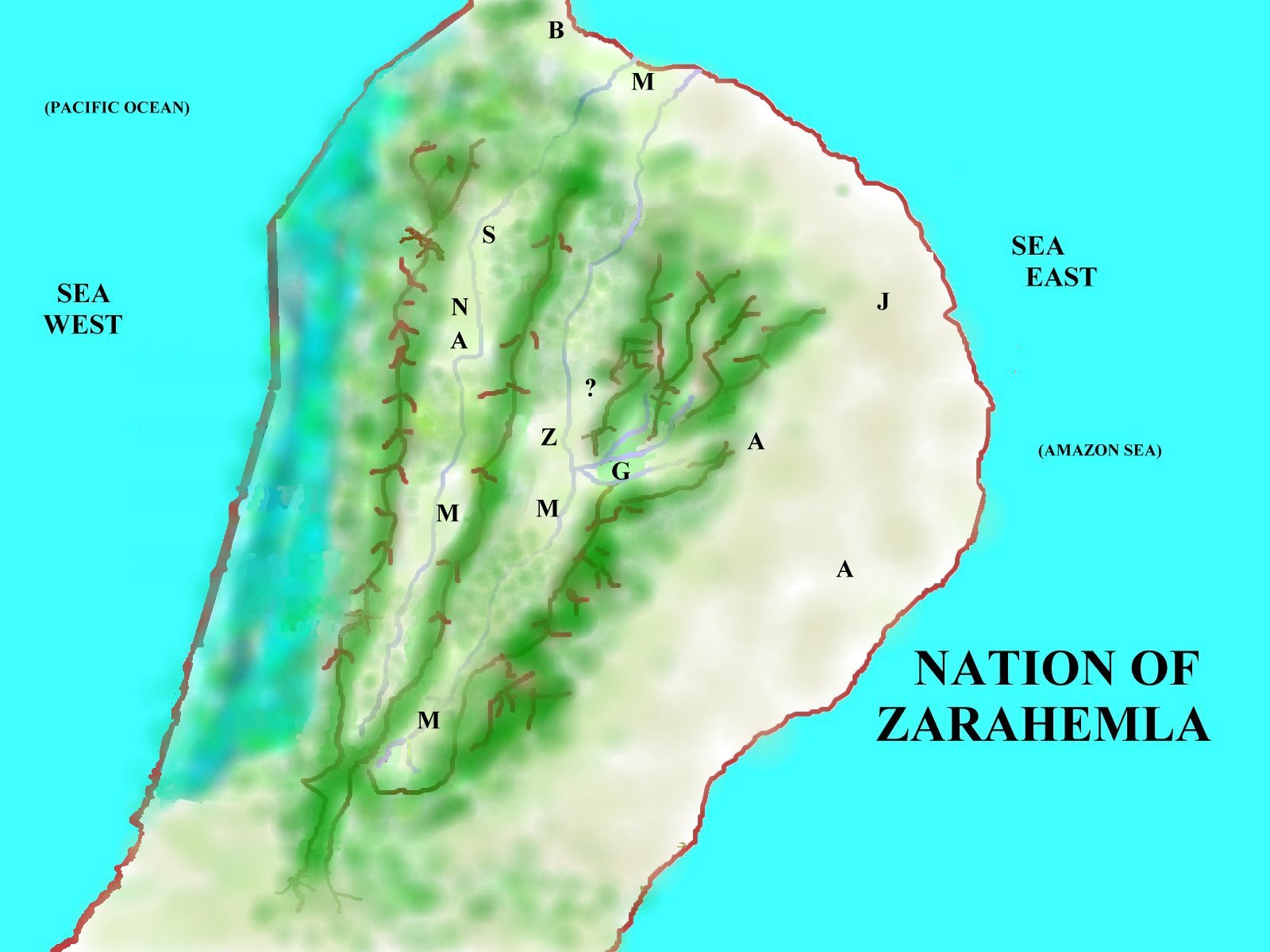 |
|||
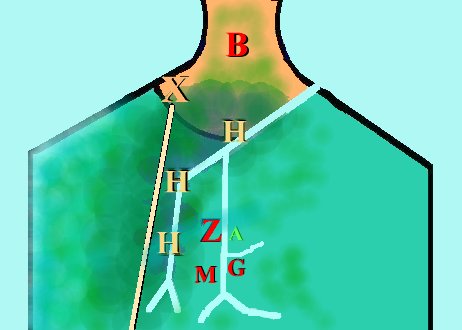
|
(Alma 2:37) |
||
| * Verse 1 [87 B.C.]. | |||
| This BM Book | Previous BM Chapter | Next BM Chapter | Commentary Page | Home Page |